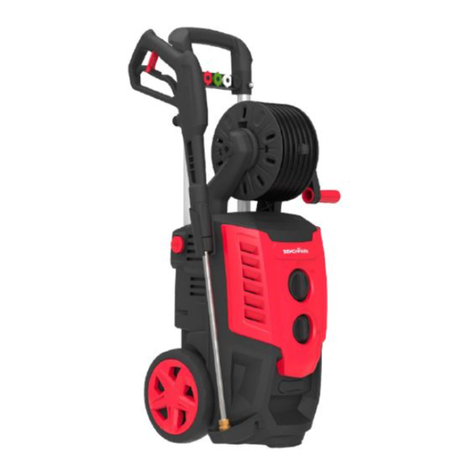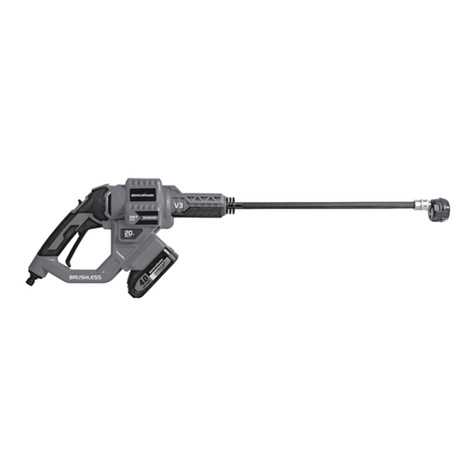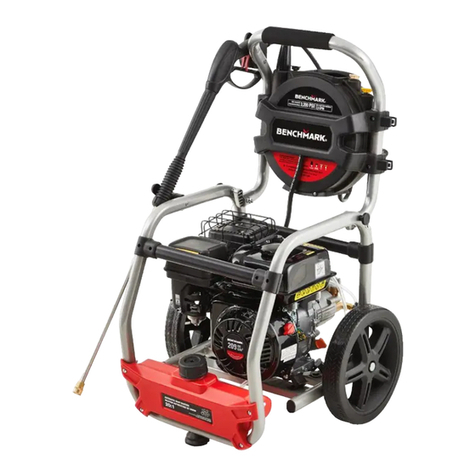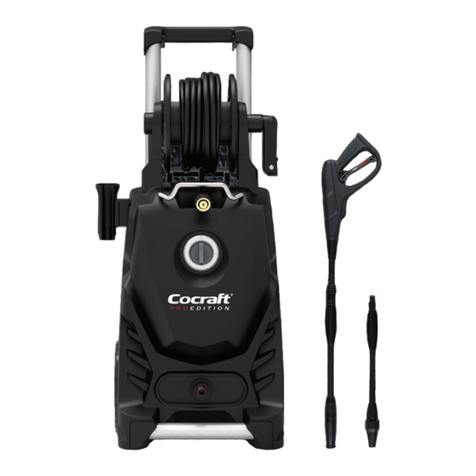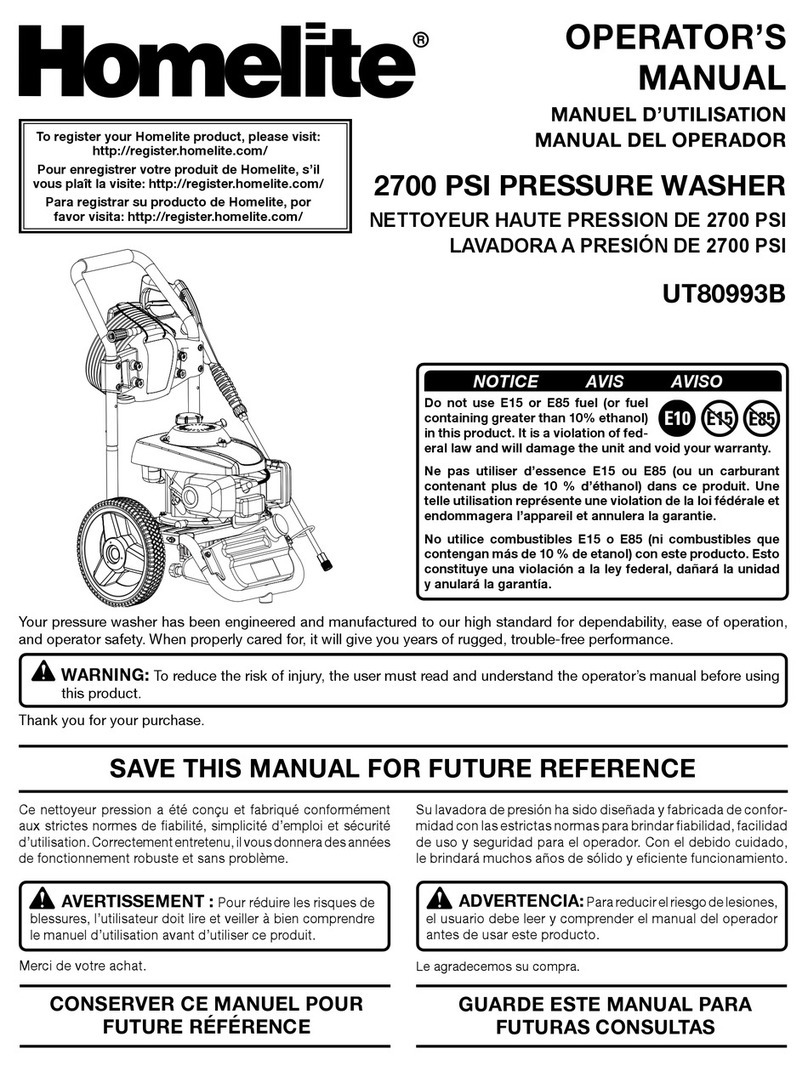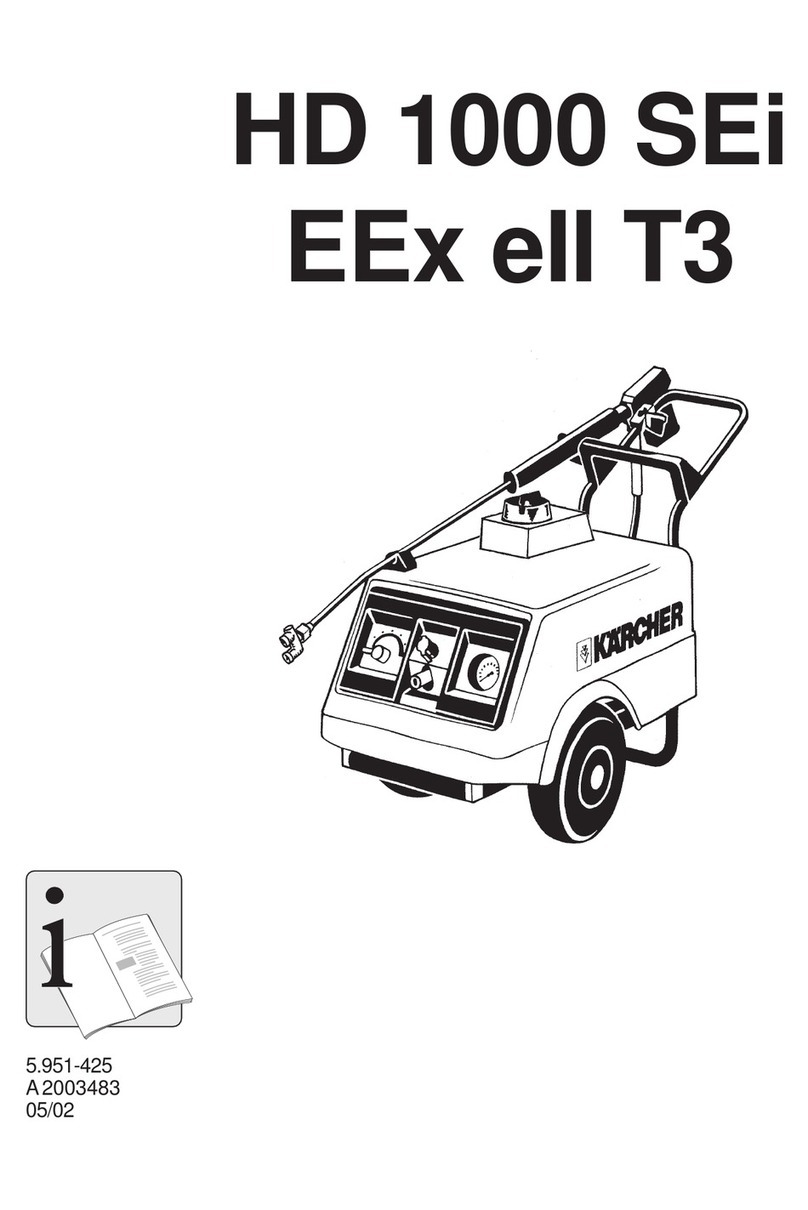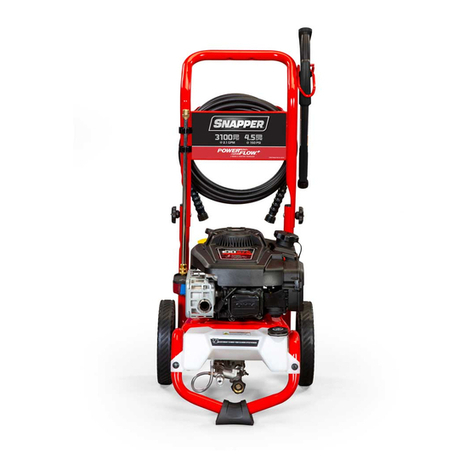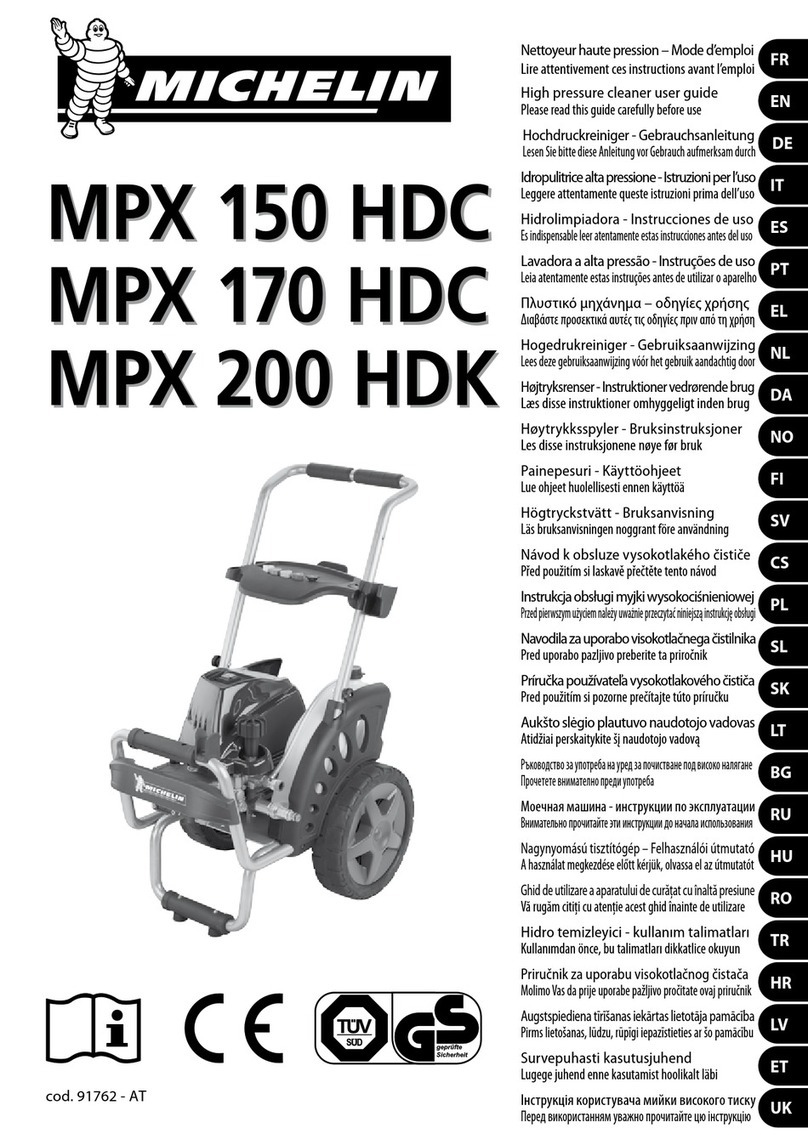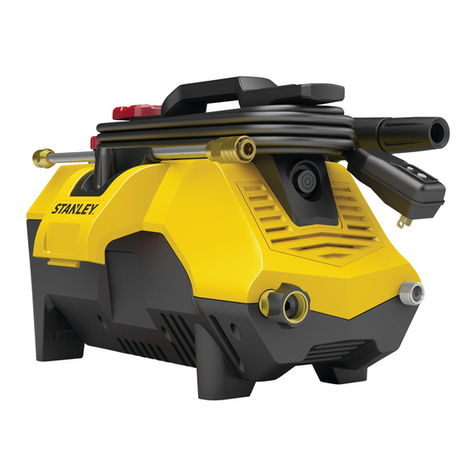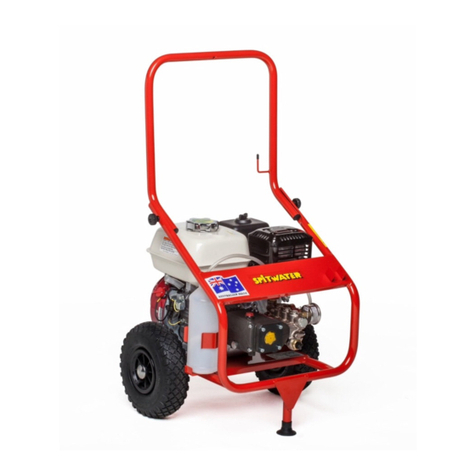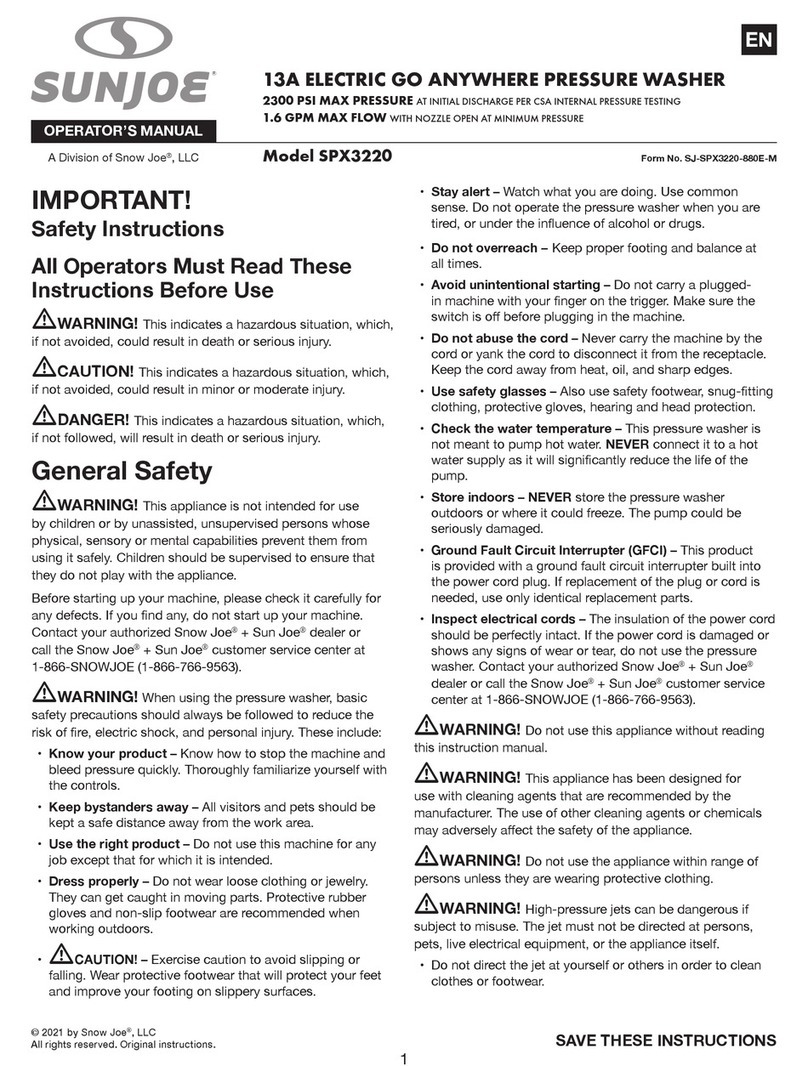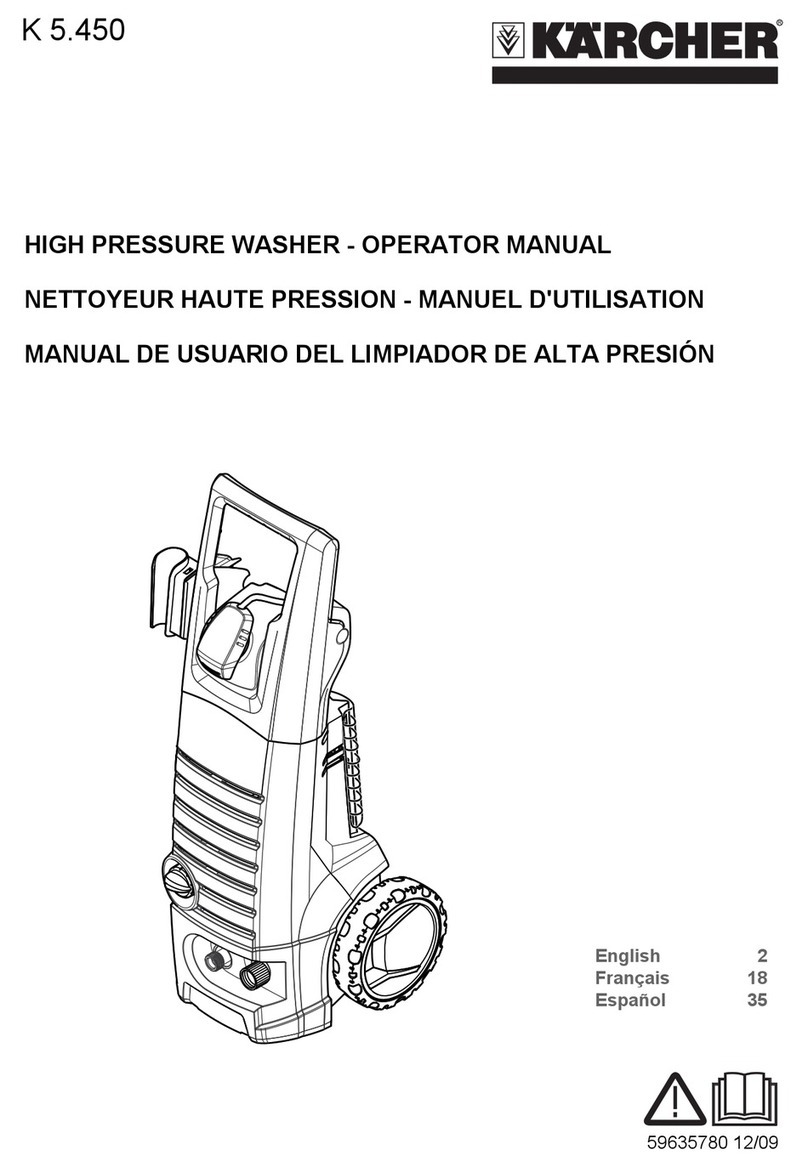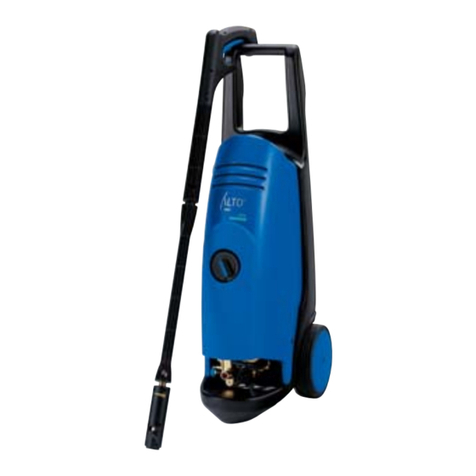Benchmark BW4400 User manual

BW4400
User Manual

The engine exhaust from this product contains chemicals known to
cause cancer, birth defects or other reproductive harm.
©2020 Benchmark. All Rights Reserved.
BW4400_UG_EN_2020-11-06

Thanks for choosing the BW Series!
Let's get started!

THIS PRODUCT MEETS ALL CERTIFICATION REQUIREMENTS FROM:

WE'VE GOT YOU COVERED!
Do not return product to store.
phone at 1-877-528-3772 if you have any questions.
SAVE THESE INSTRUCTIONS
This user guide contains important instructions for your
product, that should be followed during installation and
maintenance of the pressure washer.
This user guide covers the safety, operation and maintenance
procedures for the BW4400.
All information in this publication is based on the latest
product information available at the time of print.
No part of this publication may be reproduced
without written permission.

WARRANTY INFORMATION
email: [email protected]
online: benchmark.midlandpowerinc.com
phone: 1-877-528-3772
Warranty support, operation assistance and product support is provided by Midland
Power Inc., a licensed manufacturer of Benchmark pressure washers. Please contact
us directly for any warranty service questions.
See ‘Limited Warranty’ for more information.
Product registration is required for product support and warranty coverage. You
can register online at benchmark.midlandpowerinc.com. Once your registration is
complete, your receipt will be on file and any future warranty claims will be easily
created.

BW SERIES
TABLE OF CONTENTS
1. Safety 1
2. Learn About Your Pressure washer 5
2.1 Component Identification 5
2.2 Assembly Instructions 6
3. Pre-Operation Check 7
3.1 Prepare the Air Filter 7
3.2 Replace the Temporary Pump Oil Dipstick 8
3.3 Check Pump Oil Level 8
3.4 Add Engine Oil 9
3.5 Check the Fuel Level 11
3.6 Check the Cold Water Supply 12
3.7 Assemble the Spray Gun and Hoses 12
4. Starting your Pressure washer 15
4.1 Recoil Start 16
4.2 Stopping the Engine 18
5. Using Your Pressure washer 19
5.1. Using the Spray Wand 19
5.2. Using the Spray Nozzles 20
5.3 Working with Detergents 22
5.4 Pressure Regulator 23
5.5 Carburetor Modification for High Altitude Operation 24
6. Maintenance 25
6.1 Maintenance Schedule 26
6.2 Changing the Engine Oil 27
6.3 Changing the Pump Oil 29
6.4 Cleaning the Air-Filter 30
6.5 Nozzle Cleaning 31
6.6 Cleaning Water Inlet Filter 31
6.7 Spark Plug Service 31
6.8 Spark Arrester Maintenance 32
6.9 Fuel Filter Maintenance 32
6.10 Emission Control System 33
7. Transportation & Storage 35
8. Troubleshooting 38
9. Technical Specifications 40
10. Limited Warranty 41

1
1. SAFETY
DANGER!
Using a gas powered pressure washer indoors can kill you in minutes.
The engine exhaust from this product contains chemicals known to cause
cancer, birth defects or other reproductive harm.
1.1 OPERATOR SAFETY
WARNING!
Always perform an oil, fuel and air filter check before starting the engine.
Properly clean and maintain the equipment.
Operate the pressure washer according to instructions for safe and
dependable service.
Before operating the pressure washer, read the user guide carefully.
Otherwise, it may result in personal injuries or equipment damage.
Never run the pressure washer in an enclosed area to avoid harm from
exhaust emissions of a poisonous carbon monoxide gas.
Be careful not to touch the exhaust system during operation due to risk of
burns.
Pay attention to the warning labels. The engine exhaust system will
become heated during operation and remain hot immediately after the
engine is stopped.
Gasoline is a highly flammable and explosive liquid. Refuel in a well
ventilated area with the engine stopped.
Use of gasoline with an ethanol content greater than 10% can damage
the engine and fuel system and will void the manufacturer’s warranty.
When refueling the pressure washer, keep it away from cigarettes, open
Using an engine indoors can KILL YOU IN MINUTES.
Generator exhaust contains carbon monoxide.
This is poison that you cannot see or smell.
NEVER use inside a home
or garage. EVEN if doors
and windows are open.
Only use OUTSIDE and
far away from windows,
doors, and vents.

2BW SERIES
flames, smoke and/or sparks.
Place the pressure washer at least 3 feet away from buildings or other
equipment during operation.
Run the pressure washer on a level surface. Tilting the pressure washer
may result in fuel spills.
Know how to stop the pressure washer quickly and understand operation
of all the controls. Never permit anyone to operate the pressure washer
without proper instructions.
Keep children, pets and machinery with rotating parts away during
operation.
Do not operate the pressure washer in rain or snow.
Do not touch the spark plug while the engine is operating or shortly after
the engine has been shut down.
Wear ear and eye protection while operating this unit.
1.2 USE SAFETY
WARNING!
NEVER direct the water spray towards electrical wiring, devices, or
directly at the pressure washer itself. Fatal electric shock may occur.
NEVER direct the water flow at people. The high pressure jet can be
dangerous if misused and must not be directed at people, animals,
electrical devices or the unit itself. DO NOT TREAT FLUID INJECTION AS
A SIMPLE CUT! Seek medical help immediately.
NEVER spray flammable liquids, risk of explosion. Operate only where
open flame or torch is permitted.
Always operate on dry, solid level ground.
DO NOT expose this product to excessive moisture, dust, or dirt.
DO NOT use in areas where fumes from paint solvents or flammable
liquids pose a potential hazard.
Inspect before each use, ensure all nuts, bolts, screws, hydraulic fittings,
hose clamps, wheels. etc. are securely tightened. Always check the
oil level before operating. Never operate when the product is in poor
mechanical condition.
Never move this product while spraying.
DO NOT run the engine at high speed when you are not using the
product.
DO NOT use acids, solvents, alkaline, or flammable substances in this
product. They may cause injuries to the operator and will permanently

3
damage the machine.
Only use detergents that are designed to be specifically used with a
pressure washer. The use of other cleaning detergents may void the
warranty.
The spray gun will kick, hold with both hands.
Never run the unit dry, always be sure the water supply is turned on fully
before operating the unit.
Know how to stop the product and bleed pressure quickly. Be thoroughly
familiar with the controls.
DO NOT operate the pressure washer without the water turned on.
DO NOT overreach or stand on unstable surface. Keep good footing and
balance at all times.
Wear proper eye and ear protection while operating.
1.3 MAINTENANCE SAFETY
WARNING!
Turn o the engine before performing any maintenance. Failure to do so
can cause severe personal injury or death.
Before performing maintenance depressurize the unit by turning o the
water supply and squeezing the trigger of the spray wand until water
stops flowing.
Use rubber gloves when coming into contact with engine oil.
After any maintenance is performed, wash immediately using soap and
clean water, repeated exposure to lubricant may cause skin irritation.
Do not clean the filter element with flammable liquids like gasoline, an
explosion may occur.
Allow the pressure washer set to cool down before performing any
maintenance.
Do not spray the pressure washer itself.
Always stop the pressure washer set before removing the oil filler cap.
Only qualified maintenance personnel with knowledge of fuels and
machinery hazards should perform maintenance procedures.
Do not let water in the pump freeze. See the storage section for further
details on how to store properly during the winter.
See ‘Maintenance Schedule’ for the recommended maintenance
schedule.

4BW SERIES
1.4 OTHER SAFETY TIPS
WARNING!
Running engines give o carbon monoxide, an odourless poisonous gas
that can cause nausea, fainting, or death. Do not start engine indoors or
in an enclosed area even if the windows and doors are open.
If you start to feel sick, dizzy, or weak after the pressure washer has been
running, move to fresh air RIGHT AWAY. See a doctor. You could have
carbon monoxide poisoning.
Pressure washers vibrate in normal use. During and after the use of
the pressure washer, inspect the pressure washer as well as hoses
connected to it for damage resulting from vibration. Have damaged items
repaired or replaced as necessary. Do not use hoses that show signs of
damage such as broken or cracked insulation or damaged connectors.
TOXIC FUMES HAZARD. Running engines give off
carbon monoxide, an odourless poisonous gas
that can cause nausea, fainting, or death. Do
not start engine indoors or in an enclosed area,
even if the windows and doors are open.
DANGER TOXIQUE. Faire fonctionner un moteur dégage de
l’oxyde de carbone, un gaz inodore toxique qui peut
provoquer la nausée, évanouissement ou la mort. Ne
démarrer pas le moteur à l’intérieur ou dans une espace clos,
meme si les fenêtres et les portes sont ouvertes.
Using a generator indoors can KILL YOU IN MINUTES.
Generator exhaust contains carbon monoxide.
This is poison that you cannot see or smell.
NEVER use inside a home
or garage. EVEN if doors
and windows are open.
Only use OUTSIDE and
far away from windows,
doors, and vents.

5
2. LEARN ABOUT YOUR PRESSURE WASHER
This section will show you how to identify key parts of your pressure washer. Going
over the terminology below will make sure we’re on the same page.
2.1 COMPONENT IDENTIFICATION
Nozzle Storage
Gas Cap
Fuel Tank
Dipstick
Recoil Starter
Handle
Choke
Lever
Fuel
Lever
Trigger Safety
Spray Gun
Lance
Oil Drain Plug
Engine Switch
Flat Free Tires
High Pressure
Hose
Air Filter
Throttle
Lever
Nozzle
High Pressure
Hose Outlet
High Pressure
Hose
Water Supply
Inlet
Nozzle Storage
Gas Cap
Fuel Tank
Dipstick
Recoil Starter
Handle
Choke
Lever
Fuel
Lever
Trigger Safety
Spray Gun
Lance
Oil Drain Plug
Engine Switch
Flat Free Tires
High Pressure
Hose
Air Filter
Throttle
Lever
Nozzle
High Pressure
Hose Outlet
High Pressure
Hose
Water Supply
Inlet

6BW SERIES
2.2 ASSEMBLY INSTRUCTIONS
Setup of your pressure washer is designed to get you up and running as quickly as
possible. Cut the four corners of the carton from top to bottom instead of attempting to
lift it out of the box.
Assembling the Handle
1. Slide the main handle onto the frame.
2. Pass the saddle bolts through the hole from the outside.
3. Tighten the knobs to secure it in place.
4. Slide the upper handle onto the main handle. Press in the spring pins until
the upper handle slides down all the way and snaps in place.

7
3. PRE-OPERATION CHECK
These quick checks should be done each time the pressure washer is started to
ensure you get the most out of your pressure washer.
Set the pressure washer on a level surface and the power switch to OFF.
WARNING!
Exhaust gas contains poisonous carbon monoxide. Never run the pressure
washer in an enclosed area. Be sure to provide adequate ventilation.
Operate the pressure washer on a level surface. If the pressure washer is
tilted, fuel spillage may result. Keep away from rotating parts while the
pressure washer is running. The pressure washer is air-cooled and may
be damaged if ventilation is inadequate.
3.1 PREPARE THE AIR FILTER
Prepare the air filter before your first use. Check the maintenance schedule for a
complete cleaning guide.
1. Loosen the nut and remove the air filter cover. Remove the air filter housing
and elements and inspect for cleanliness.
2. Gently shake the paper filter or blow with air to remove the dust and debris.
3. Clean the foam air filter with soap and water or solvent and let dry.
4. Soak the foam filter in clean engine oil.
5. Gently squeeze and then pat out all excess oil and reinstall. If excess oil
remains in the foam filter it can seep through to the paper filter and damage
it.
Air Filter
Housing
Foam Air
Filter
Paper Air
Filter
Wing Nut

8BW SERIES
6. Replace either filter if it is damaged.
NOTE
Running the engine without the air filter will quickly degrade the engine
Always inspect air filter before using the pressure washer. Check and
clean the air filter according to the maintenance schedule.
3.2 REPLACE THE TEMPORARY PUMP OIL DIPSTICK
Your pressure washer ships with a red non-vented oil fill plug. Before starting the
pump replace the red non-vented dipstick with the included vented oil fill plug.
3.3 CHECK PUMP OIL LEVEL
1. Loosen the pump oil dipstick located on top of the pump.
2. To accurately read the oil level insert the dipstick into the hole without
threading it in. Ensure the reading is between the minimum and maximum fill
lines.
3. Replace pump oil dipstick and tighten.
Air Filter
Housing
Foam Air
Filter
Paper Air
Filter
Wing Nut

9
3.4 ADD ENGINE OIL
1. Ensure the pressure washer is on a level surface.
2. Unscrew one of the two oil dipsticks and clean the dipstick.
3. Check the oil level by reinserting the oil dipstick without screwing it back in.
Remove the dipstick and examine the oil level. If the level is at or below the
minimum oil level marked on the dipstick, refill to the maximum oil level mark.
4. Reinsert the dipstick and tighten securely.
Note
Oil max. capacity: BW4400 (1.1L)
Do not tilt the pressure washer when adding engine oil. This could result
in overfilling and damage to the engine.
Using non-detergent or 2-stroke oil could shorten the engine’s working
life.
Use high quality engine oil with strong detergents.
Handle and store the engine oil with care, avoid getting dirt or dust into
the engine oil.
Do not mix dierent engine oils.
Before the engine oil falls below the safety margin, the low oil alert
system will automatically shut o the engine. The low oil light will turn on.
To avoid the inconvenience of unexpected engine shuto, check the
engine oil level as often as possible.
Use 4-stroke engine oil, certified to meet or exceed API standard SG, SF,
SAE ratings
Maximum Oil Level
Minimum Oil Level
0°C 10 20 30 40 50-10-20-30
20 32°F 40 60 80 100 120
°C
°F0-20
15W-50
10W-30
Synthetic 5W-30
5W-30
Effective Viscosity Range of Engine Oils
8.6
8.6.2)Ta
a ft
8.6.2)Ta ke off the s pa rk a rres ter
a fter the eng ine cool down.
8.6.2)Ta k e off the s pa rk a rr es te r from the
a fte r the eng ine c ool d own.

10 BW SERIES
Maximum Oil Level
Minimum Oil Level
0°C 10 20 30 40 50-10-20-30
20 32°F 40 60 80 100 120
°C
°F0-20
15W-50
10W-30
Synthetic 5W-30
5W-30
Effective Viscosity Range of Engine Oils
8.6
8.6.2)Ta
a ft
8.6.2)Ta k e off the s pa rk a rre s ter
a fter the eng ine cool down.
8.6.2)Ta k e off the s pa rk a rr es te r from the
a fte r the eng ine c ool d own.
Maximum Oil Level
Minimum Oil Level
0°C 10 20 30 40 50-10-20-30
20 32°F 40 60 80 100 120
°C
°F0-20
15W-50
10W-30
Synthetic 5W-30
5W-30
Effective Viscosity Range of Engine Oils
8.6
8.6.2)Ta
a ft
8.6.2)Ta k e off the s pa rk a rre s ter
a fter the eng ine cool down.
8.6.2)Ta k e off the s pa rk a rr es te r from the
a fte r the eng ine c ool d own.

11
3.5 CHECK THE FUEL LEVEL
WARNING!
Gasoline is highly flammable and explosive under certain conditions.
Refuel in a well-ventilated area with the engine stopped. Do not smoke
or allow open flames or sparks in the area where the pressure washer
is being refueled or where gasoline is stored. Do not overfill the tank. Be
careful not to spill fuel when refueling. Wipe up any spilled gasoline and
let the area dry before starting the engine.
Gasoline substitutes such as gasohol are not recommended. They may be
harmful to the fuel system components.
1. Check the fuel level by removing the fuel tank cap to visually check the level.
2. Add fuel until the level reaches 1.5" below the top of the neck. Tighten the
fuel cap securely after refilling.
Note
Only use unleaded gasoline (Pump Octane 87 or higher).
Never use stale or contaminated gasoline, or an oil/gasoline mixture.
Avoid getting dirt or water into the fuel tank.
Do not use a mixture of gasoline containing methanol. This will cause
serious damage to the engine.
Use of gasoline with an ethanol content greater than 10% can damage
the engine and fuel system and will void the manufacturer’s warranty.

12 BW SERIES
3.6 CHECK THE COLD WATER SUPPLY
Check local regulations of your municipal water company to check if
a backflow prevention device is required when hooking up to drinking
water. This ensures no feedback of chemicals will return to the water
supply. Use a water filter to avoid potential damage from dirt in the water
supply.
Garden hose must be at least 3/4" diameter
Flow rate of water must not fall below 8.0GPM
Flow rate can be determined by running hose into an empty 5 gallon pail
for 1 minute
The water supply temperature must not exceed 40°C/104°F
Never use the pressure washer to draw in water contaminated with
solvents eg. paint thinners, gasoline, oil etc.
Always prevent debris from being drawn into the unit by using a clean
water source and additional water filter.
DO NOT operate pressure washer without the water turned on.
3.7 ASSEMBLE THE SPRAY GUN AND HOSES
DANGER!
NEVER direct the water flow at people. The high pressure jet can be
dangerous if misused and must not be directed at people, animals,
electrical devices or the unit itself. DO NOT TREAT FLUID INJECTION AS
A SIMPLE CUT! Seek medical help immediately.
1. Rotate the coupler on the trigger handle assembly clockwise to tighten the
spray wand. Tighten by hand.

13
2. Attach the spray gun to the high pressure hose by pulling back on the collar
of the female hose fitting and inserting the male spray gun end into it. Tug on
the connection to ensure the connection is secured.
INSTALL THE DETERGENT SIPHON HOSE
1. Attach one end of the detergent siphon hose to the barb fitting near the high
pressure hose connection of the pump.
2. Place the other end of the siphon hose with filter into the container with the
detergent solution.
Note
The soap nozzle will draw detergent at a ratio of 1:25.
8.6
8.6
8. 6. 3) U s
s p
re
8.6.4)R e
8. 6 .3) U s e abrus h to r emove c a r bo
s pa rk a rres te r . I f the s pa rk a
repla ce i t.
8. 6. 4)R eins ta ll t he s pa rk a rres te r a
8. 6 .3) U s e ab rus h to r e move c a rb on d epos
s pa rk a rre s te r . I f the s pa rk a rres ter i
repl a ce i t.
8. 6. 4) R ei ns ta ll t he s pa rk a rr es ter a nd m uff
Table of contents
Languages:
Other Benchmark Pressure Washer manuals
